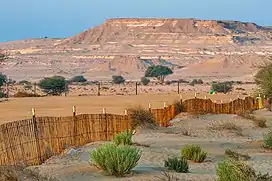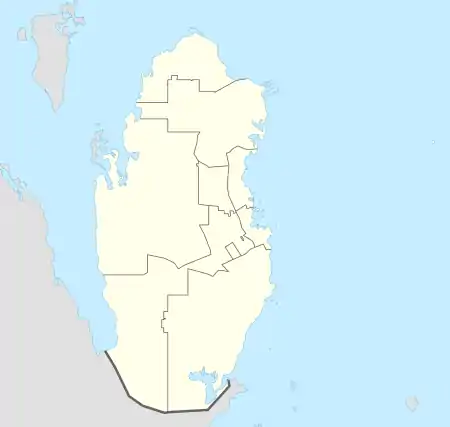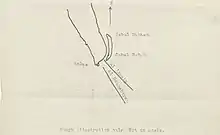| Jebel Nakhsh | |
|---|---|
 Fenced-off area of Jebel Nakhsh | |
| Highest point | |
| Elevation | 90 m (300 ft) |
| Coordinates | 24°52′27″N 50°54′13″E / 24.874080°N 50.903528°E[1] |
| Geography | |
 Jebel Nakhsh Qatar | |
| Location | Qatar |
| Geology | |
| Mountain type | Mountain ridge |
Jebel Nakhsh (Arabic: جبل النخش; also known as Khashm Al Nakhsh) is a mountain ridge in southern Qatar that stands roughly 90 meters (300 ft) tall[2] and which runs southeast-to-northwest for 33 km side by side with the western coast.[3] Three main rock layers make up the mountain, the bottom layer containing multiple burrows and being primarily composed of limestone, marl, and shale, the middle layer, which is also the largest, being made up of limestone, marl, stromatolitic limestone and evaporites, and the top layer comprising mainly limestone, which is sedimentary.[4]
Geology
The British, after surveying the mountain and sending samples to be tested in London in the summer of 1947, decided that it should be mined for gypsum. The Holloway Brothers were commissioned to oversee operations and to set up a mine railway to Umm Bab. A small labor camp was also established in the area. As much as 75 tons of gypsum had been quarried from the mountain by July 1948. The contract was later handed off to the C.A.T. Company, and by October 1948 the amount of gypsum extracted increased to 200 tons. From January 1949 to July 1949, a total of 420 tons had been extracted, and from August to the close of the year, 650 tons. Jacques Leblanc, a geologist working for QatarEnergy, notes that while the British report explicitly mentions Jebel Nakhsh, the mountain bears no apparent signs of exploitation and that it may be a case of mistaken identity.[5]
The Miocene Dam Formation is the predominant formation of Jebel Nakhsh and of that formation, the three members exposed on the mountain's surface are the 6-meter thick Abu Samrah Member on top, 33-meter thick Nakhsh Member in the middle and the 27-metre thick Salwa Member on the bottom. The Nakhsh Member is very rich in gypsum and is the only member of the Dam Formation to contain stromatolites.[4]
The bottom layer, largely made up of soft clays, is particularly fragile and chemical weathering of the clay surfaces has caused the underlying limestone to collapse in some areas, thus forming suitable abodes for certain desert mammals such as foxes and hyenas. There has also been instances recorded of mammals mechanically burrowing into these fragile surfaces.[6] Its caves were first surveyed in 1983–84 by Peter Whybhrow.[3]
Jebel Nakhsh is in southern Qatar and falls within the boundaries of Al Rayyan Municipality. It is near the border with Saudi Arabia to the south and the Gulf of Salwah to the west. The hill of Qarn Abu Wayil is approximately 2 km to the south.[3]
History

The jebel was a site of contention in the early-to-mid 20th century between Ibn Saud and Amir Abdullah bin Jassim Al Thani. Ibn Saud had wanted Jebel Nakhsh to be Saudi Arabia's frontier with Qatar. According to him, the Qatari Amir had previously signed an agreement ceding Jebel Nakhsh to him, although the Amir denied this.[7] In a 1935 correspondence between British diplomats concerning the Saudi–Qatar frontier, the British claimed that "they [the Qataris] could never consent to attribute to Saudi Arabia features, such, for example, as the Jebel Naksh, which form an integral part of the physical structure of the Qatar Peninsula itself and have always, in fact, been an equally integral part of the Sheikhdom."[8] In the following weeks, a British communique stated that they "could not agree to deprive the Sheikh of any portion of the main block of that peninsula".[9]
References
- ↑ Jacques Leblanc (December 2015). "A Historical Account of the Stratigraphy of Qatar, Middle-East (1816 to 2015)": 208. Retrieved 22 February 2019.
{{cite journal}}: Cite journal requires|journal=(help) - ↑ Frances Gillespie (14 March 2016). "A Walk Through Time". Marhaba. Retrieved 22 February 2019.
- 1 2 3 Peter Andrews (2008). "Cetaceans From a Possible Striped Hyaena Den Site in Qatar" (PDF). Journal of Taphonomy. 6 (3–4): 258. Retrieved 22 February 2019.
- 1 2 Jacques Leblanc (October 2009). "A Fossil Hunting Guide to the Miocene of Qatar, Middle East: A Geological & Macro-Paleontological Investigation of the Dam Formation". p. 16-21. Retrieved 22 February 2019.
- ↑ Jacques Leblanc (December 2015). "A Historical Account of the Stratigraphy of Qatar, Middle-East (1816 to 2015)": 73. Retrieved 22 February 2019.
{{cite journal}}: Cite journal requires|journal=(help) - ↑ Peter Andrews (2008). "Cetaceans From a Possible Striped Hyaena Den Site in Qatar" (PDF). Journal of Taphonomy. 6 (3–4): 257. Retrieved 22 February 2019.
- ↑ "Coll 6/67(4) 'Boundaries of South Eastern Arabia and Qatar.' [294r] (587/843)". Qatar Digital Library. 1936. Retrieved 22 February 2019.
- ↑ "'File 61/31 IV (D 120) Anglo-Saudi frontier negotiations' [137r] (286/512)". Qatar Digital Library. 1935. Retrieved 22 February 2019. This article incorporates text from this source, which is in the public domain.
- ↑ "'File 1/A/38 III Negotiations with Bin Saud re: Eastern Boundary of Saudi Arabia.' [178r] (364/504)". Qatar Digital Library. 1935. Retrieved 22 February 2019.